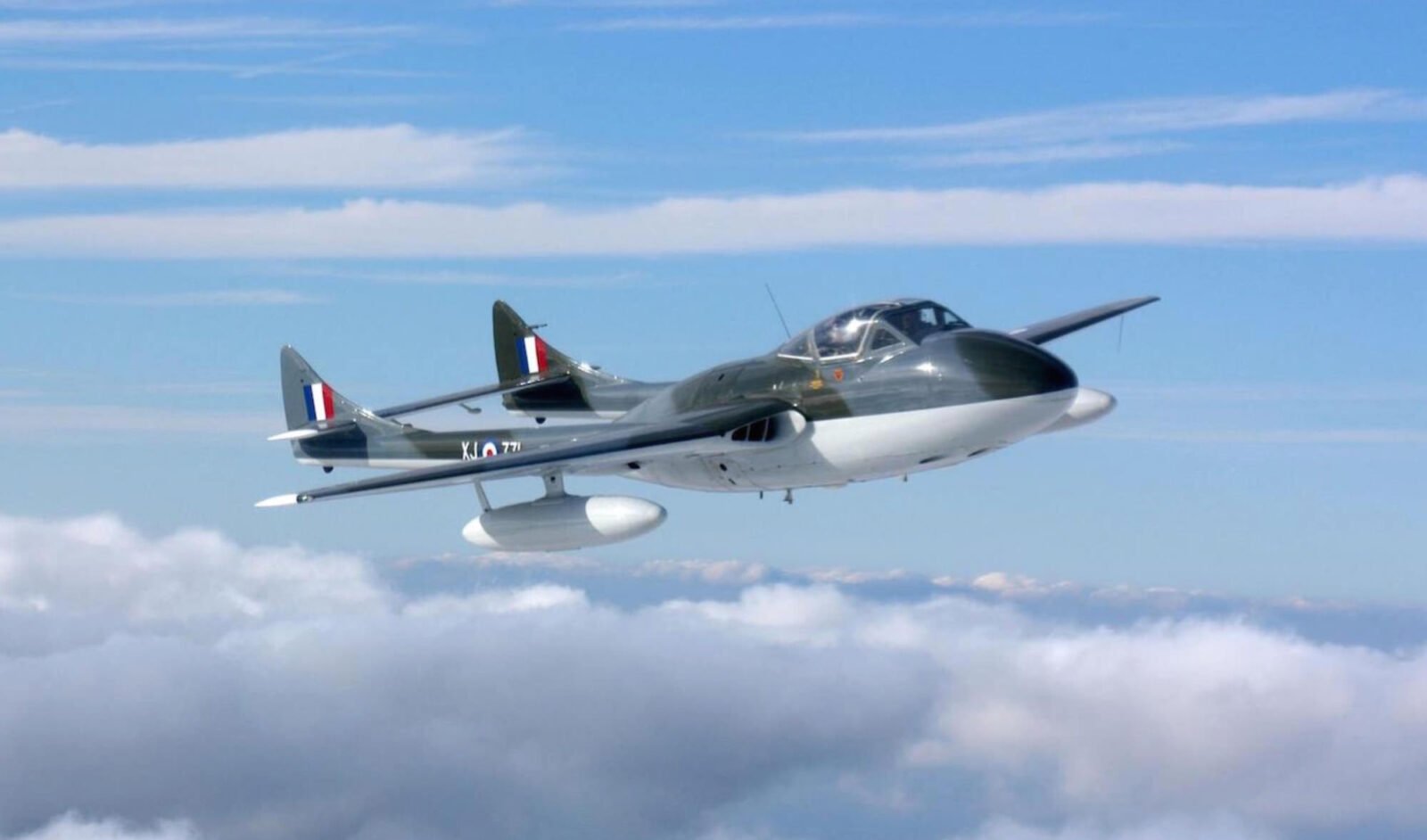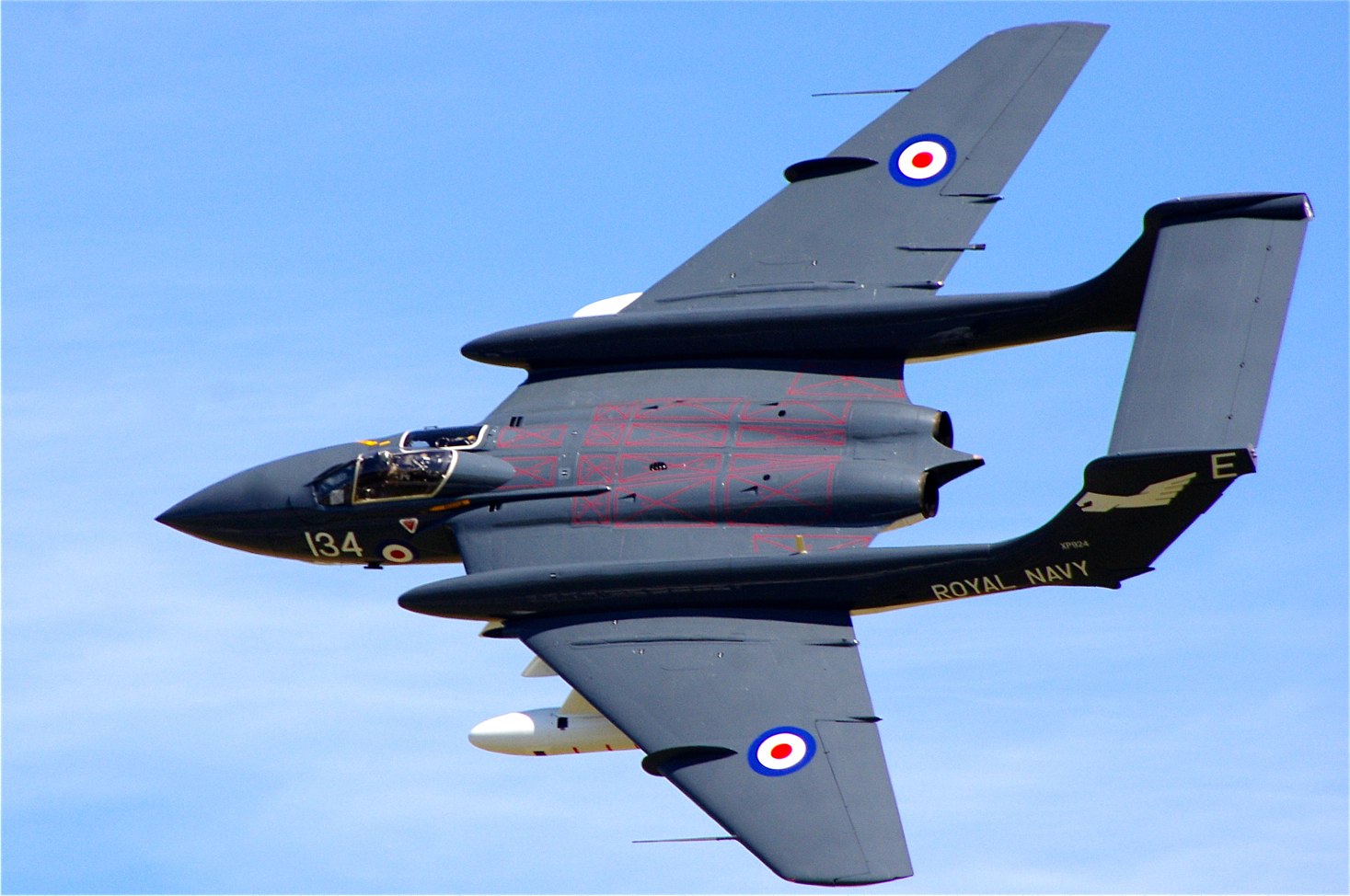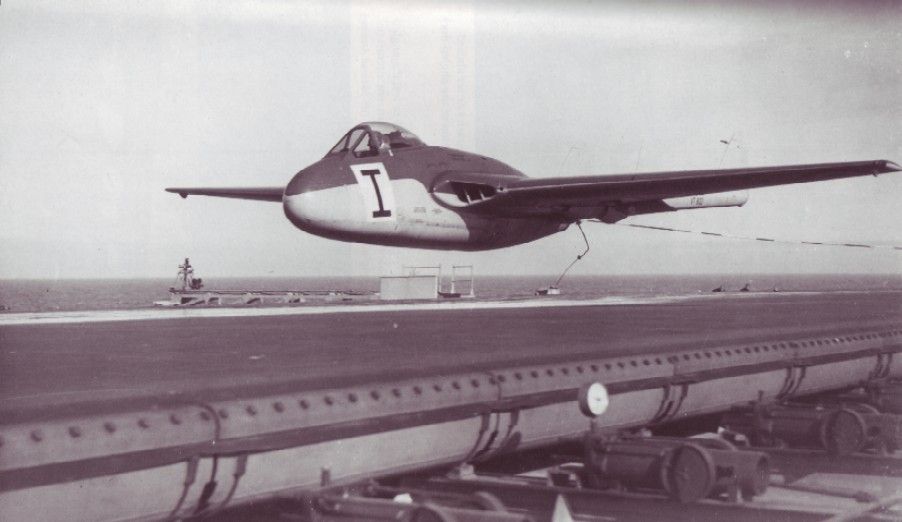De Havilland DH100 Sea Vampire F1 UK Navy Aviation Photo

Aircraft overview: Designed and built at Hatfield and first flown in 1949, the DH112 Venom single-seat fighter was a progressive development of the Vampire. It had a fatter fuselage 'pod' to take the much larger, higher thrust DH Ghost engine, and a thinner and more efficient wing . It was the first RAF fighter to have wing-tip fuel tanks.
De Havilland DH115 Sea Vampire T22 UK Navy Aviation Photo

DH100 Sea Vampire F1 landing on HMS Ocean 3rd December 1945 The type was very successful in the export market, providing many air forces with their first experience of jet fighter operations and around 30 air forces were ultimately to operate the type.
De Havilland DH100 Sea Vampire F1 UK Navy Aviation Photo

The prototype Sea Vampire was the first jet to fly from an aircraft carrier. The Vampire flew with the air forces of more than 15 countries, the last being the Swiss Air Force which retired them in 1999; 56 years after the type's first flight! The type was initially developed under the name 'Spidercrab'.
de Havilland Vampire Jet

The Vampire's twin-boom configuration enabled the jet tailpipe to remain short in order to extract as much thrust as possible from the somewhat low-powered engines of the day. The prototype Sea Vampire was the first jet aircraft to fly from an aircraft carrier. Current Location: Reserve Hangar, Canada Aviation and Space Museum. Provenance:
Picture of De Havilland DH.115 Sea Vampire T22 taken at RNAS Yeovilton

On 3 December 1945 a Royal Navy "Sea Vampire" became the first jet-powered fighter to operate off the decks of an aircraft carrier. By 1946, the renamed DH 100 Vampire had entered active service. Later improvements lead to the Mk. III version with larger fuel tanks and an improved tail design.
Vampire Pair Norwegian Historical Squadron A de Havilland Sea Vampire

The gap between the Sea Vampires Mks 20 and 23 was filled by the Mk 21 which was a variant that took off with a droppable undercarriage and landed on a strengthened belly on a rubberised deck.. The Vampire is the forgotten jet fighter yet together with the Meteor it brought the RAF into the jet era, likewise the later Venom.It would appear.
Sea Vampire

The De Havilland Aircraft Company DH110 Sea Vixen was originally ordered as a two-seat, twin-boom and radar-equipped fighter to specification F.4/48 and was in direct competition with the Gloster Javelin. Although losing in that competition, the Royal Navy felt that the De Havilland DH110 was a better basis for a carrier-based fleet defence.
Vampire Fighter Empires & Allies Wiki Fandom powered by Wikia

The de Havilland Sea Venom is a British postwar carrier-capable jet aircraft developed from the de Havilland Venom. It served with the Royal Navy Fleet Air Arm and with the Royal Australian Navy. The French Navy operated the Aquilon, developed from the Sea Venom FAW.20, built under licence by SNCASE (Sud-Est). Design and development
De Havilland DH115 Sea Vampire T22 Australia Navy Aviation Photo

The prototype sea Vampire was the first jet aircraft to fly from an aircraft carrier. Current Location: Jet Age Exhibition, Canada Aviation and Space Museum Provenance: Transfer from the Royal Canadian Air Force
This fine example of the de Havilland Sea Vampire T11 jet aircraft

The Vampire also became the first jet aircraft to land and take off from an aircraft carrier, when Captain Eric "Winkle" Brown used a Sea Vampire to achieve that feat on the HMS Ocean in December 1945. An altitude record was set by the Vampire, with a Ghost engine powering it, of 59,446 ft in March 1948 by John Cunningham. via Wikipedia
De Havilland Sea Vampire fighter / fighter bomber Vintage aircraft

A79-841 crashed on 9 October 1956 into the sea off Greenwell Point near Nowra, NSW. The pilot, Commander Daniel Buchanan, RAN was declared missing, presumed dead. The wreckage was eventually recovered in April 1974 when it became entangled in a fisherman's nets. A79-837 crashed at Laverton, VIC in October 1967.
De Havilland Sea Vampire Prototype 3 by Graham Wood Photo Collection

On 3 December 1945, the "Sea Vampire" performed the very first jet carrier landings and take-offs, with Lieutenant Commander Eric Brown performing several landings and take-offs on the HMS OCEAN off the Isle of Wight.. Two "Sea Vampire F.21" machines were built in 1948, both being similar to the Sea Vampire F.20 but with a reinforced belly.
de Havilland Sea Vampire F.Mk.21 Aircraft of World War II

De Havilland Sea Vampire Mk.10 takes off from HMS Ocean, 3 December 1945. (BAE Systems) Captain Eric Melrose Brown, C.B.E., D.S.C., A.F.C., KCVSA, Ph.D., Hon. F.R.Ae.S., R.N., is one of aviation's greatest test pilots. He was born at Leith, Scotland, 21 January 1918, the son of Robert John Brown and Euphemia Melrose Brown.
De Havilland Vampire at the Thunder Over Michigan Airshow, 2014. Photo

The de Havilland Vampire is a British jet fighter which was developed and manufactured by the de Havilland Aircraft Company. It was the second jet fighter to be operated by the RAF, after the Gloster Meteor, and the first to be powered by a single jet engine .
de Havilland Sea Vampire T.22 AviationMuseum

A long-serving single-seat fighter bomber, two seat night fighter and shipborne strike aircraft. DH112 Venom FB.1 prototype photographed in September 1949 before tailplane tip extensions were added. The De Havilland Aircraft Company DH112 Venom was a post-war single-engined jet fighter.
DE HAVILLAND VAMPIRE JET Recovery Curios

The Vampire was a versatile aircraft, setting many aviation firsts and records, being the first RAF fighter with a top speed exceeding 500 mph. On December 3, 1945, a Sea Vampire (piloted by Captain Eric "Winkle" Brown), was the first jet to take off and land from an aircraft carrier.